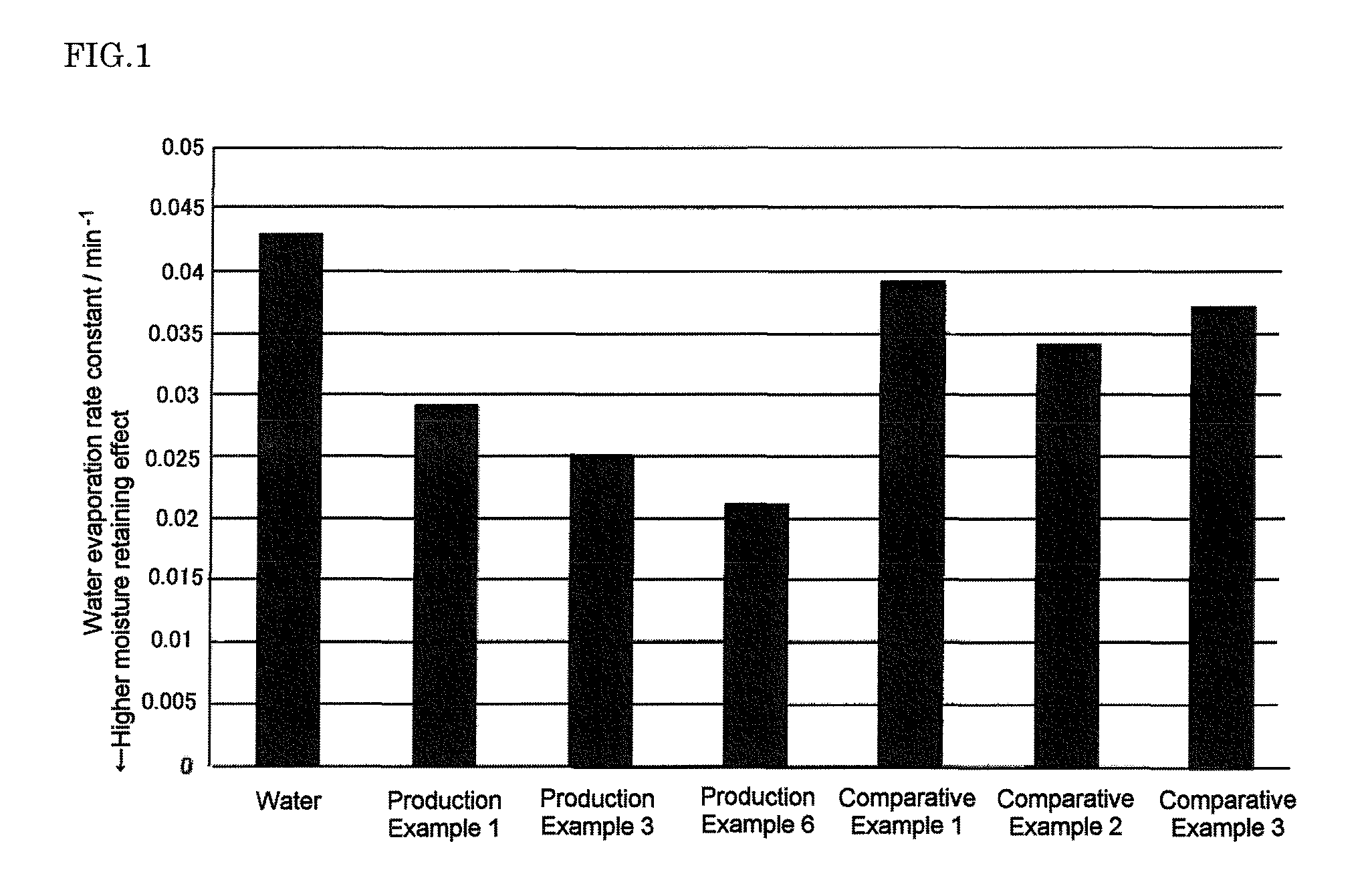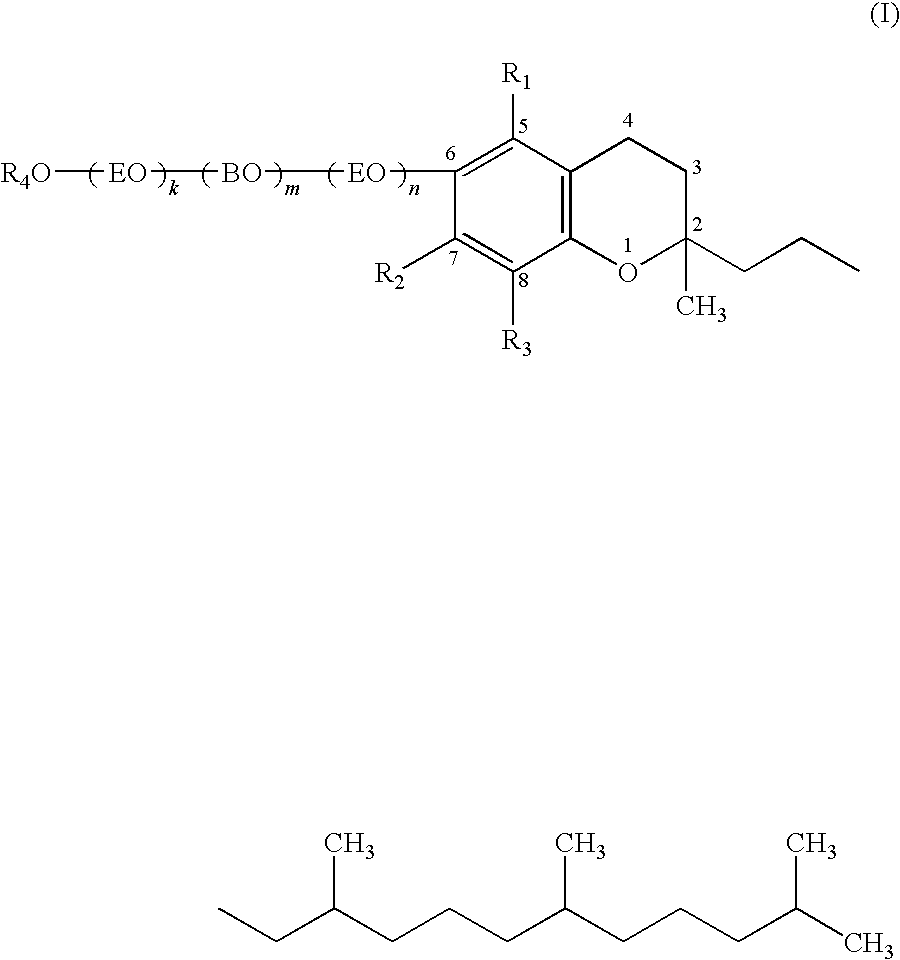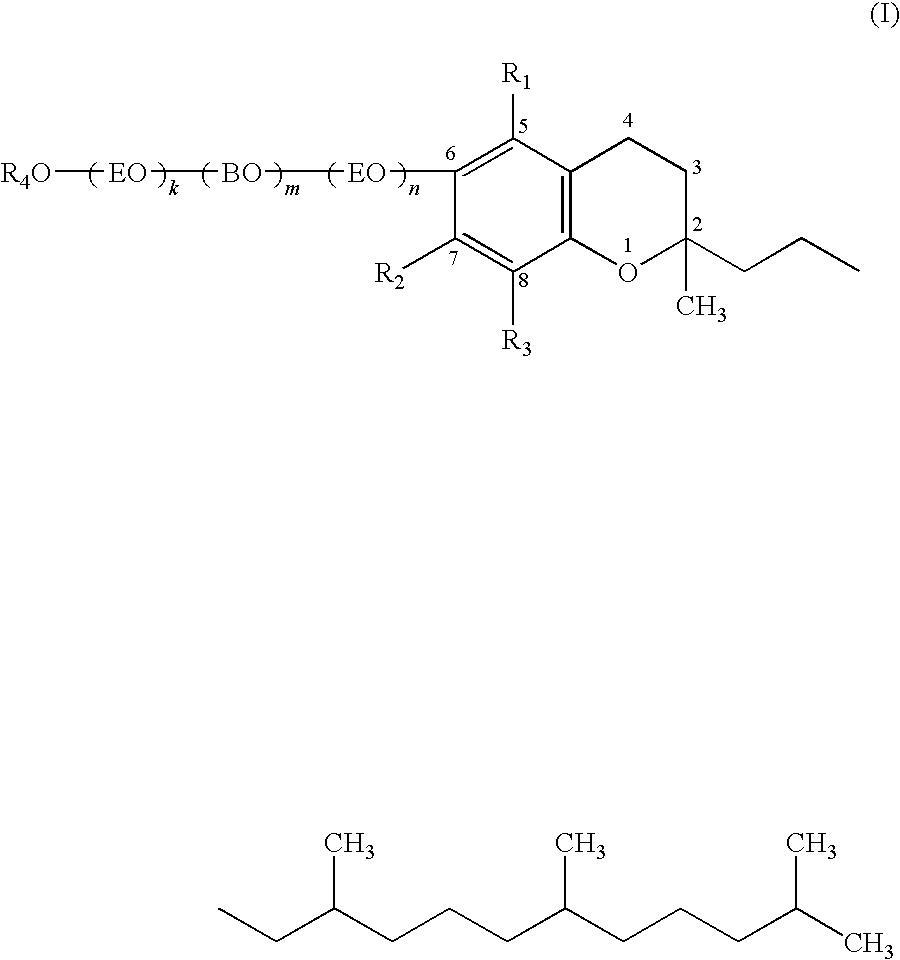Cosmetics
a vitamin e and derivative technology, applied in the field of cosmetics, can solve the problems of inability to realistically be used as cosmetic raw materials, unsatisfactory solubilizing agents or emulsifiers, etc., and achieve the effects of preserving both antioxidant activity, good emulsifying ability and solubilizing ability
- Summary
- Abstract
- Description
- Claims
- Application Information
AI Technical Summary
Benefits of technology
Problems solved by technology
Method used
Image
Examples
production example 1
Potassium salt of DL-α-tocopherol ethylene oxide / butylene oxide / ethylene oxide addition product sulfuric acid ester [in the above-described formula (I), k=5, m=2, n=1, block, R1, R2, R3=CH3, R4=potassium salt of SO3]
(i) Synthesis of DL-α-tocopherol ethylene oxide / butylene oxide / ethylene oxide addition product (k=5, m=2, n=1, block)
[0099]Into an autoclave, 205.1 g of DL-α-tocopherol and 0.61 g of potassium hydroxide (0.30 mass % with respect to DL-α-tocopherol), as the base catalyst, were loaded. After the inside of the vessel was replaced with nitrogen gas, the temperature was increased to 100-110° C., and the dehydration was conducted for 0.5 hours. Then, the temperature was increased to 130-140° C., 21.0 g of ethylene oxide was injected over the course of 0.5 hours, and aging was carried out for 4.0 hours. Subsequently, 68.6 g of butylene oxide was injected at 140-150° C. over the course of 0.5 hours, and then aging was carried out for 2.0 hours. After the completion of aging, the...
production example 2
DL-α-tocopherol ethylene oxide / butylene oxide / ethylene oxide addition product [in the above-described formula (I), k=16, m=2, n=0, R1, R2, R3=CH3, R4=H]
[0117]Into an autoclave, 134.6 g of DL-α-tocopherol and 0.40 g of potassium hydroxide, as the base catalyst, were loaded. After the inside of the vessel was replaced with nitrogen gas, the temperature was increased to 100-110° C., and the dehydration was conducted for 0.5 hours. Then the temperature was increased to 140-150° C., and 45.0 g of 1,2-butylene oxide was injected over the course of 0.5 hours. While the same temperature was being maintained, aging was carried out for 4.0 hours. Subsequently, 220.0 g of ethylene oxide was injected over the course of 2.5 hours, and then aging was carried out for 2.0 hours. After the completion of aging, the cooling was carried out, and the product was neutralized with phosphoric acid aqueous solution and purified. The formed salt was filtered, and 347.2 g of the desired product (yield: 86.8%)...
production example 3
DL-α-tocopherol ethylene oxide / butylene oxide / ethylene oxide addition product [in the above-described formula (I), k=14, m=2, n=14, block, R1, R2, R3=CH3, R4=H]
[0129]Into an autoclave, 60.5 g of DL-α-tocopherol (manufactured by Riken Vitamin Co., Ltd.) and 0.24 g of potassium hydroxide, as the base catalyst, were loaded. After the inside of the vessel was replaced with nitrogen gas, the temperature was increased to 100-110° C., and the dehydration was conducted for 0.5 hours. Then, the temperature was increased to 130-140° C., and 86.5 g of ethylene oxide (manufactured by Nippon Shokubai Co., Ltd.) was injected over the course of 1.5 hours. While the same temperature was being maintained, aging was carried out for 1.0 hour. Subsequently, 16.3 g of 1,2-butylene oxide (manufactured by Tokyo Chemical Industry Co., Ltd.) was injected over the course of 0.5 hours, and then aging was carried out for 2.0 hours. Lastly, 86.3 g of ethylene oxide was injected over the course of 1.0 hour, and ...
PUM
| Property | Measurement | Unit |
|---|---|---|
| temperature | aaaaa | aaaaa |
| temperature | aaaaa | aaaaa |
| temperature | aaaaa | aaaaa |
Abstract
Description
Claims
Application Information
 Login to View More
Login to View More - R&D
- Intellectual Property
- Life Sciences
- Materials
- Tech Scout
- Unparalleled Data Quality
- Higher Quality Content
- 60% Fewer Hallucinations
Browse by: Latest US Patents, China's latest patents, Technical Efficacy Thesaurus, Application Domain, Technology Topic, Popular Technical Reports.
© 2025 PatSnap. All rights reserved.Legal|Privacy policy|Modern Slavery Act Transparency Statement|Sitemap|About US| Contact US: help@patsnap.com



